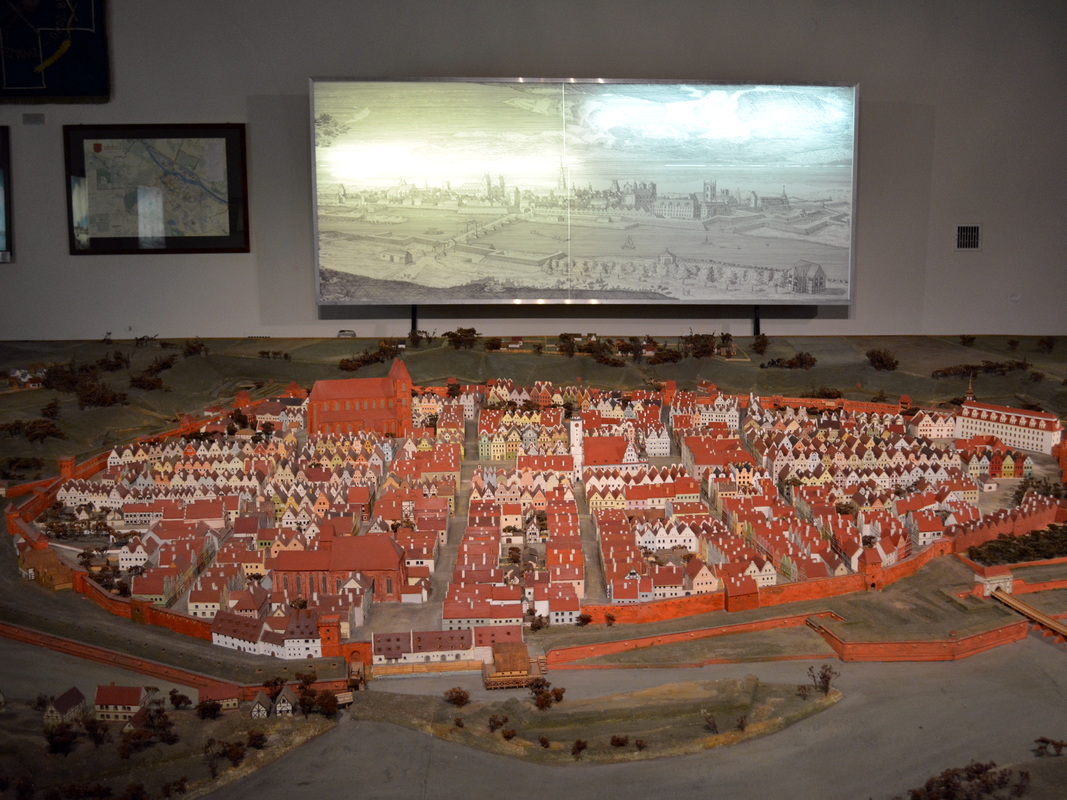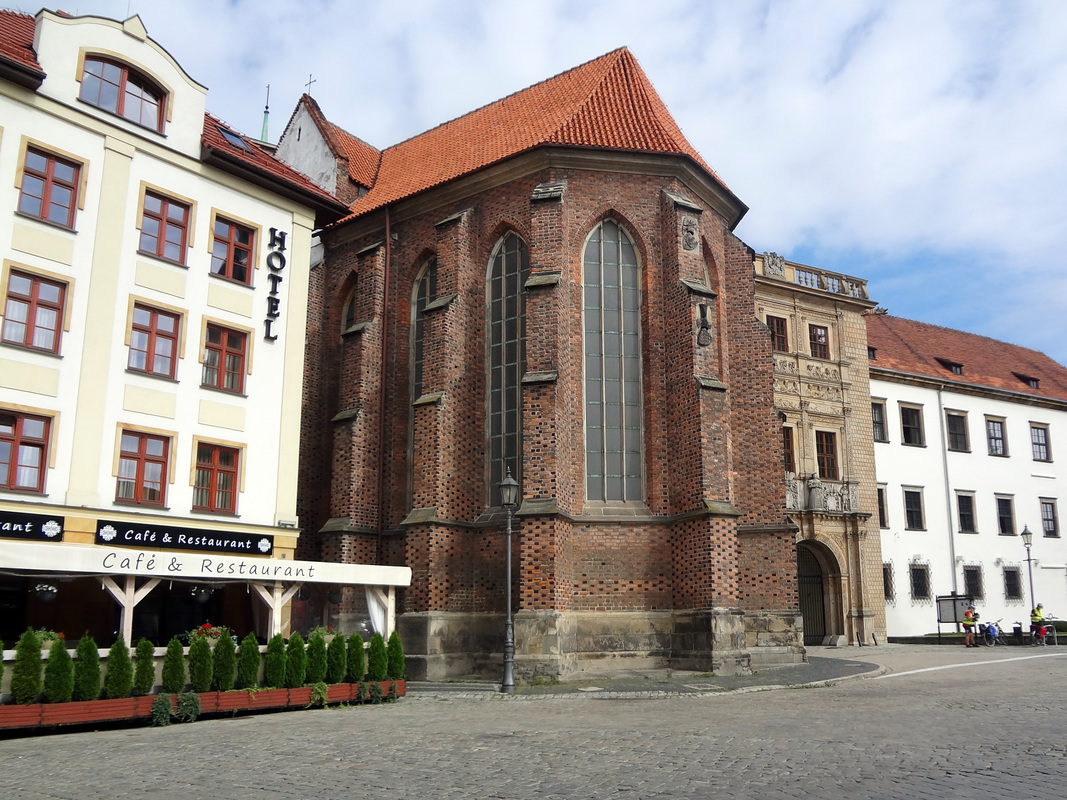Brzeg Poland
Exploring a Historic Castle and Stunning Cathedral
Our last stop during our day trips from Wroclaw, Poland was the historic town of Brzeg on the river Odra. Brzeg which was ruled by the Piast Dynasty (Poland’s oldest ruling family), received its charter from Wroclaw Duke Henry III (The White) in 1245 and from 1311 to 1675 was the capital of the duchy of Legnica-Brzeg.
The town is believed to have been first fortified early in the 13th century. As you enter the town the first thing that catches your eye is the impressive Brzeg Castle and the tall imposing Holy Cross Church a few yards away. Brzeg also has a lovely market square and several other historic sites to visit, but we were limited in time, so we focused on the two for which we had made the road-trip.
Above Photo Credit: Town square - By Adam Dziura (adamdziura.9g.pl) - Own work, CC BY-SA 3.0, https://commons.wikimedia.org/w/index.php?curid=737091
If you have a limited amount of time as we did that day, you may want to start with the sites most appealing to you, so we decided to see the historic castle first, followed by a visit to the beautiful Jesuit church.
Earliest reports of a castle’s existence describe a small fortress with a moat and fortified walls, built in 1235 during the reign of Henry I (The Bearded). Soon after, a Gothic Castle was constructed. The Piast family dynasty occupied the castle from 1311 until 1675 and during that time, the castle was remodeled and extended several times. In 1370, Prince Ludvik I extended the castle and constructed its chapel. The 14th century Gothic chapel, St. Jadwiga (St. Hedwig) survives from this period of the castle.
The castle was transformed into a Renaissance palace in the second half of the 16th century. The work was completed by the architects Jakub and Franciszek Parr and Bernard Niuron during the years 1530-1580 and modelled on the Krakow royal residence. A complex consisting of three wings, a circular courtyard, arched ambulatory. In 1554 a tower was added over the entrance gate with wall featuring busts of the Piast family members and ancestors.
Over the centuries the castle suffered great destruction from war and fire as was the case with many Polish castles. In 1966, restoration began to bring the castle back to its Renaissance appearance.
Earliest reports of a castle’s existence describe a small fortress with a moat and fortified walls, built in 1235 during the reign of Henry I (The Bearded). Soon after, a Gothic Castle was constructed. The Piast family dynasty occupied the castle from 1311 until 1675 and during that time, the castle was remodeled and extended several times. In 1370, Prince Ludvik I extended the castle and constructed its chapel. The 14th century Gothic chapel, St. Jadwiga (St. Hedwig) survives from this period of the castle.
The castle was transformed into a Renaissance palace in the second half of the 16th century. The work was completed by the architects Jakub and Franciszek Parr and Bernard Niuron during the years 1530-1580 and modelled on the Krakow royal residence. A complex consisting of three wings, a circular courtyard, arched ambulatory. In 1554 a tower was added over the entrance gate with wall featuring busts of the Piast family members and ancestors.
Over the centuries the castle suffered great destruction from war and fire as was the case with many Polish castles. In 1966, restoration began to bring the castle back to its Renaissance appearance.
We spent several minutes admiring the lovely restored architecture, but the Museum of the Silesian Piasts, housed within the castle proved to be a most interesting and fun experience.
The museum collection includes artefacts related to the history of the city of Brzeg and its environs, as well as that of the Silesian Piasts and the Piast tradition in that region. It has an extensive collection including medieval art (sculptures and altar paintings), Silesian and foreign paintings from the seventeenth and eighteenth centuries, prints with views of Brzeg, its castle and other Silesian cities, and weapons from the sixteenth to the twentieth centuries
Upon entering, you are directed first to the Mausoleum built in 1567, which honors the Silesian Piast dynasty. We walked through the arched brick space taking in the rows of coffins and tombs some of which were elaborately decorated or sculpted with resting figures. Some of the stone effigies, interestingly, had small sculpted companions at their feet.
The museum collection includes artefacts related to the history of the city of Brzeg and its environs, as well as that of the Silesian Piasts and the Piast tradition in that region. It has an extensive collection including medieval art (sculptures and altar paintings), Silesian and foreign paintings from the seventeenth and eighteenth centuries, prints with views of Brzeg, its castle and other Silesian cities, and weapons from the sixteenth to the twentieth centuries
Upon entering, you are directed first to the Mausoleum built in 1567, which honors the Silesian Piast dynasty. We walked through the arched brick space taking in the rows of coffins and tombs some of which were elaborately decorated or sculpted with resting figures. Some of the stone effigies, interestingly, had small sculpted companions at their feet.
What really makes this museum particularly fun are the wax models dressed in historic costume that populate the exhibits, bringing the antiques and artifacts to life!
Brzeg Castle and its Museum of the Silesian Piasts were well worth the drive, but our visit to Brzeg wasn’t over yet, so we headed out of the castle and across the square to the Holy Cross Church and needless to say, it was as ornate and gorgeous as we had come to expect Poland’s fabulous Baroque Churches.
Holy Cross Church was built between 1734 to 1739 and the towers were added between 1854 and 1856. The ceiling frescoes were painted by J. Kubena (1739-1745) presenting the glory of the Holy Cross, the missions of the Jesuit Order, and figures of saints. This frothy Baroque beauty of a church is a delight to visit.
Holy Cross Church was built between 1734 to 1739 and the towers were added between 1854 and 1856. The ceiling frescoes were painted by J. Kubena (1739-1745) presenting the glory of the Holy Cross, the missions of the Jesuit Order, and figures of saints. This frothy Baroque beauty of a church is a delight to visit.
Every road trip should include a break for coffee and a snack (no alcohol when driving!), so we stopped for cake and ice-cream at nearby Arte Hotel and Restaurant before heading back to Wroclaw. Jim ordered Sernik Czecoladowy (Chocolate Cheese Cake) and I ordered Deser Lodowy z Owocami I bita smietana (Ice Cream with Fruit and Whipped Cream) which was so delicious it brought up the eternal question….Why is ice cream always so much better in Europe?
Sitting out on the café terrace, enjoying delicious deserts, is a perfect way to end an afternoon in lovely historic Brzeg. It turned out to be an amazing day in the countryside of Silesia!


















































